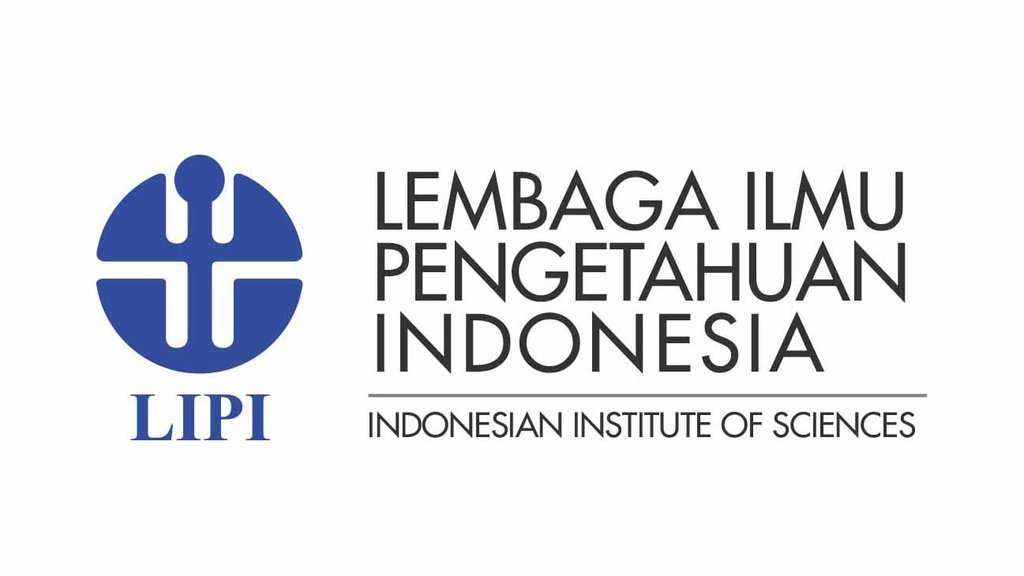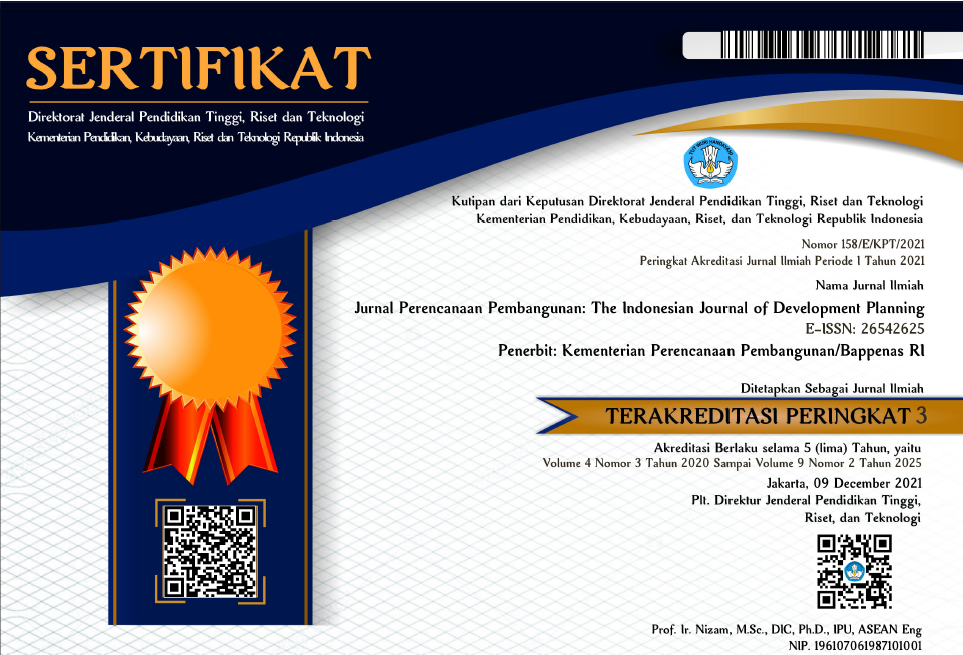Do Economic Complexity and Strong Institutions Affect Income Inequality
DOI:
https://doi.org/10.36574/jpp.v5i3.213Keywords:
economic complexity, income inequality, institutions, two-step system GMMAbstract
This study investigates the relationship of a country's sophisticated products and institutional indicators on income inequality. Cross-country OLS and fixed-effects estimate regression analysis show that countries with productive economic structures have less inequality. Meanwhile, three government indicators in accountability, political stability, and the rule of law show mixed results. Using the system generalized method of moments (GMM) to control endogeneity, we find evidence of a causal link from economic complexity to income inequality in the short run. Meanwhile, the government's political stability is not a significant predictor.
Downloads
References
Acemoglu, D., Johnson, S., & Robinson, J. A. (2001). The colonial origins of comparative development: An empirical investigation. The American Economic Review, 91(5), 1369-1401.
Acemoglu, D., & Robinson, J. A. (2012). Why nations fail: The origins of power, prosperity, and poverty. Currency.
Ahluwalia, M. S. (1976). Income distribution and development: Some stylized facts. The American Economic Review, 66(2), 128-135.
Arellano, M., & Bond, S. (1991). Some tests of specification for panel data: Monte Carlo evidence and an application to employment equations. The Review of Economic Studies, 58(2), 277-297.
Arellano, M., & Bover, O. (1995). Another look at the instrumental variable estimation of error components models. Journal of Econometrics, 68(1), 29-51.
Artadi, E. V., & Sala-i-Martin, X. (2003). The economic tragedy of the XXth century: Growth in Africa (No. w9865). National Bureau of Economic Research.
Audi, M., & Ali, A. (2017). Exploring the Linkage between corruption and economic development in case of selected developing and developed nations. Munich Personal RePEc Archive, 83158.
Barro, R. J. (2008). Inequality and growth revisited (No. 11). ADB working paper series on regional economic integration.
Bates, R. H. (2013). The Imperial Peace in Colonial Africa and Africa's Underdevelopment. Africa's Development in Historical Perspective, Cambridge: Cambridge University Press, forthcoming.
Blundell, R., & Bond, S. (1998). Initial conditions and moment restrictions in dynamic panel data models. Journal of Econometrics, 87(1), 115-143.
Bond, S. R. (2002). Dynamic panel data models: a guide to micro data methods and practice. Portuguese Economic Journal, 1(2), 141-162.
Bourguignon, F. (2004). The poverty-growth-inequality triangle (No. 125). working paper.
Bustos, S., Gomez, C., Hausmann, R., & Hidalgo, C. A. (2012). The dynamics of nestedness predicts the evolution of industrial ecosystems. PloS One, 7(11), e49393.
Caldarelli, G., Cristelli, M., Gabrielli, A., Pietronero, L., Scala, A., & Tacchella, A. (2012). A network analysis of countries' export flows: firm grounds for the building blocks of the economy. PloS One, 7(10), e47278.
Collier, P., & Gunning, J. W. (1999). Why has Africa grown slowly?. Journal of Economic Perspectives, 13(3), 3-22.
Deininger, K., & Squire, L. (1998). New ways of looking at old issues: inequality and growth. Journal of Development Economics, 57(2), 259-287.
Duflo, E. (2004). The medium-run effects of educational expansion: Evidence from a large school construction program in Indonesia. Journal of Development Economics, 74(1), 163-197.
Easterly, W., & Levine, R. (1997). Africa's growth tragedy: policies and ethnic divisions. The Quarterly Journal of Economics, 112(4), 1203-1250.
Engerman, S. L., & Sokoloff, K. L. (1994). Factor endowments: institutions, and differential paths of growth among new world economies. National Bureau of Economic Research.
Galbraith, J. K., Halbach, B., Malinowska, A., Shams, A., & Zhang, W. (2014). UTIP global inequality data sets 1963-2008: Updates, revisions, and quality checks. The University of Texas working paper.
Glaeser, E. L., La Porta, R., Lopez-de-Silanes, F., & Shleifer, A. (2004). Do institutions cause growth?. Journal of Economic Growth, 9(3), 271-303.
Goodman, B., & Hirschman, A. O. (1959). The Strategy of Economic Development. Journal of Farm Economics, 41(2), 468.
Guo, G. (2009). China's local political budget cycles. American Journal of Political Science, 53(3), 621-632.
Hall, R. E., & Jones, C. I. (1999). Why do some countries produce so much more output per worker than others?. The Quarterly Journal of Economics, 114(1), 83-116.
Hartmann, D. (2014). Economic complexity and human development: How economic diversification and social networks affect human agency and welfare. Taylor & Francis.
Hartmann, D., Guevara, M. R., Jara-Figueroa, C., Aristarán, M., & Hidalgo, C. A. (2017). Linking economic complexity, institutions, and income inequality. World Development, 93, 75-93.
Harvard's Growth Lab. (n.d.). Japan's Export Complexity. The Atlas of Economic Complexity. https://atlas.cid.harvard.edu/countries/114/export-complexity.
Hausmann, R., Hidalgo, C. A., Bustos, S., Coscia, M., & Simoes, A. (2014). The atlas of economic complexity: Mapping paths to prosperity. MIT Press.
Hidalgo, C. A., & Hausmann, R. (2009). The building blocks of economic complexity. Proceedings of the national academy of sciences, 106(26), 10570-10575.
Hidalgo, C. A., Klinger, B., Barabási, A. L., & Hausmann, R. (2007). The product space conditions the development of nations. Science, 317(5837), 482-487.
Jones, B. F., & Olken, B. A. (2005). Do leaders matter? National leadership and growth since World War II. The Quarterly Journal of Economics, 120(3), 835-864.
Judson, R. A., & Owen, A. L. (1999). Estimating dynamic panel data models: a guide for macroeconomists. Economics Letters, 65(1), 9-15.
Kanbur, R. (2012). Does Kuznets still matter?. Working paper.
Kaufmann, D., Kraay, A., & Mastruzzi, M. (2009). Governance matters VIII: aggregate and individual governance indicators, 1996-2008. World Bank Policy Research working paper, (4978).
Khan, H., Khan, U., & Khan, M. A. (2020). Causal nexus between economic complexity and FDI: Empirical evidence from time series analysis. The Chinese Economy, 53(5), 374-394.
Kim, D. H., Hsieh, J., & Lin, S. C. (2019). Financial liberalization, political institutions, and income inequality. Empirical Economics, 1-37.
Knack, S., & Keefer, P. (1995). Institutions and economic performance: cross?country tests using alternative institutional measures. Economics & Politics, 7(3), 207-227.
Kuznets, S. (1955). Economic growth and income inequality. American Economic Review, 45(2), 1–28.
Lee, K. K., & Vu, T. V. (2019). Economic complexity, human capital, and income inequality: a cross-country analysis. The Japanese Economic Review, 1-24.
Nickell, S. (1981). Biases in dynamic models with fixed effects. Econometrica: Journal of the Econometric Society, 1417-1426.
North, D. C. (1990). Institutions, institutional change, and economic performance. Cambridge University Press.
North, D. C., & Thomas, R. P. (1973). The rise of the western world: A new economic history. Cambridge University Press.
Perotti, R. (1996). Democracy, income distribution, and growth: What the data say. Journal of Economic Growth, 1(2), 149-187.
Rodrik, D. (2003). Institutions, integration, and geography: In search of the deep determinants of economic growth. In Search of Prosperity: Analytic Country Studies on Growth. Princeton University Press.
Romer, D., & Chow, C. (1996). Advanced macroeconomic theory. McGraw-Hill. Shapiro, MD
Romer, P. M. (1990). Endogenous technological change. Journal of Political Economy, 98(5, Part 2), S71-S102.
Roodman, D. (2009). How to do xtabond2: An introduction to difference and system GMM in Stata. The Stata Journal, 9(1), 86-136.
Sachs, J. D., & Warner, A. M. (1997). Fundamental sources of long-run growth. The American Economic Review, 87(2), 184-188.
Saviotti, P. P., Pyka¤, A., & Jun, B. (2020). Diversification, structural change, and economic development. Journal of Evolutionary Economics, 30, 1301-1335.
Simoes, A. J. G., & Hidalgo, C. A. (2011, August). The economic complexity observatory: An analytical tool for understanding the dynamics of economic development. In workshops at the twenty-fifth AAAI conference on artificial intelligence.
Stiglitz, J. E. (1996). Some lessons from the East Asian miracle. The World Bank Research Observer, 11(2), 151-177.
Stiglitz, J. E. (2018). From manufacturing-led export growth to a twenty-first-century inclusive growth strategy: Explaining the demise of a successful growth model and what to do about it (No. 2018/176). WIDER working paper.
Stiglitz, J., Sen, A., & Fitoussi, J. P. (2009). The measurement of economic performance and social progress revisited. Reflections and overview. Commission on the measurement of economic performance and social progress, Paris.
Wan, G., Wang, C., & Zhang, X. (2021). The Poverty-Growth-Inequality Triangle: Asia 1960s to 2010s. Social Indicators Research, 153(3), 795-822.
Wooldridge, Jeffrey M. 2010. Econometric analysis of cross-section and panel data (2 ed.). MIT Press.
Downloads
Published
How to Cite
Issue
Section
License
This is an open-access article distributed under the terms of the Creative Commons Attribution-NonCommercial-ShareAlike 4.0 International License. Copyright © Kementerian PPN/Bappenas RI


















